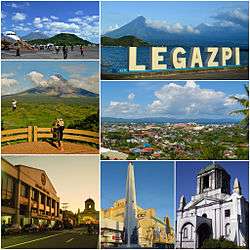Legazpi, Albay
| Legazpi City | ||
|---|---|---|
| Component City | ||
|
Clockwise from top right: JCI Legazpi Tourism Marker, View from The Oriental Legazpi, Cathedral of St. Gregory the Great, Battle of Legazpi Monument, Legazpi City Hall, Zip-line at Ligñon Hill, Legazpi Airport | ||
| ||
|
Nickname(s): City of Fun and Adventure[1] Gateway of Southern Luzon[2] Gateway City of Bicol[3] | ||
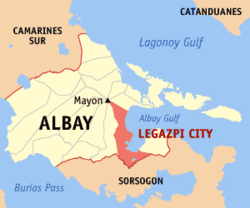 Map of Albay showing the location of Legazpi City | ||
.svg.png) Legazpi City Location within the Philippines | ||
| Coordinates: 13°08′N 123°44′E / 13.13°N 123.73°ECoordinates: 13°08′N 123°44′E / 13.13°N 123.73°E | ||
| Country | Philippines | |
| Region | Bicol (Region V) | |
| Province | Albay | |
| District | 2nd district | |
| Founded | 1616 | |
| Cityhood | June 12, 1959 | |
| Barangays | 70 | |
| Government[4] | ||
| • Mayor | Noel Rosal | |
| • Vice Mayor | Oscar Robert H.Cristobal | |
| Area[5] | ||
| • Total | 153.7 km2 (59.3 sq mi) | |
| Population (2015 census)[6] | ||
| • Total | 196,639 | |
| • Density | 1,300/km2 (3,300/sq mi) | |
| Time zone | PHT (UTC+8) | |
| ZIP code | 4500 | |
| IDD : area code | +63 (0)52 | |
| Income class | 2nd class; urban[7] | |
| Website |
legazpi | |
Legazpi, officially the City of Legazpi (Bikol: Ciudad nin Legazpi; Filipino: Lungsod ng Legazpi) and often referred to as Legazpi City, is a component city and the capital of the province of Albay in the Philippines. According to the 2015 census, it has a population of 196,639.[6] Legazpi City is the administrative center and largest city of the Bicol Region, in terms of population.[8][9] It is one of the centers of tourism, education, health services, commerce[10] and transportation[2] in the Bicol Region.
The city is composed of two districts: Legazpi Port and Old Albay district. Mayon Volcano, one of the Philippines' most popular icons and tourist destinations, is partly within the city's borders.[11]
Legazpi was recognized as the most business-friendly city in Southern Luzon in 2007 by the Philippine Chamber of Commerce and Industry.[12][13] In 2014, the city was ranked second among the top three livable cities in the Philippines in the Livable Cities Design Challenge organized by the National Competitiveness Council (NCC) and the Asia-Pacific Economic Cooperation.[14][15] In 2016, Legazpi was named overall third most competitive component city in the Philippines by the National Competitiveness Council.[16]
Etymology
Legazpi was named after Miguel López de Legazpi, the Basque Spanish conquistador who officially annexed the Philippine Islands to the Spanish Empire in 1565, and whose surname came from a town in Gipuzkoa, Spain.
History
Pre-Hispanic
The area that is now Albay had a thriving civilization before the Spanish arrived.[17] The Spanish explorers found densely populated settlements with an abundance of gold and provisions in the southern Bicol peninsula.[18] Ancient inhabitants practiced rice cultivation, made fine gold jewelry and possessed silk, suggesting trade with China.[18] American anthropologist Henry Otley Beyer found jars, stone tools and shells from 100 to 500 BC in Sorsogon and Albay.[19] Meanwhile, ancient burial jars and pottery were also found in Hoyop-Hoyopan Cave in Camalig.[20] Other evidences of pre-Hispanic civilization include the Mataas shell scoop, which dates back to the Late Neolithic Period, found in Cagraray Island.[21] The Mataas shell scoop was declared a National Cultural Treasure by the National Museum of the Philippines.[22]
Foundation
Legazpi was originally a fishing settlement called Sawangan that occupied the mangrove swamps that is now the Legazpi Port, inhabited by fisher folk and farmers.[23] In 1569, a Spanish expedition dispatched by Miguel Lopez de Legazpi led by Luis Enriquez de Guzman and Agustinian friar Alonso Jimenez first set foot in Albay. They arrived on the coastal settlement called Ibalon in present-day Magallanes, Sorsogon after exploring the islands of Masbate, Ticao and Burias and proceeded inland as far as present-day Camalig, Albay.[18][24]
In July 1573, the conquistador Juan de Salcedo, grandson of Governor-General Legazpi, led another expedition from the north. They founded Villa Santiago de Libon (present-day Libon, Albay) and reached the settlement of Albaybay, whose name was subsequently shortened to 'Albay' or Pueblo de Albay. In 1616, Pueblo de Albay served as the capital of Partido de Ibalon, which included present-day Albay, Sorsogon, Masbate, parts of Camarines Sur and the islands of Catanduanes, Ticao and Burias.[25]
Spanish colonial era
Spanish religious missionaries administered the settlement in the 1580s. In 1587, Franciscan friars of the Doctrina de Cagsawa began to convert the area's population to Christianity. The village of Sawangan became more populous and progressive and the first parish priest, Fray Francisco de Sta. Ana, OFM, built a wooden chapel with St. Gregory the Great as patron. Sawangan then became an independent parish and was called 'Misión de San Gregorio Magno de Sawangan'.[26]
A bigger and more imposing church replaced the chapel during the tenure of Fray Martin del Espiritu OFM in 1636 and Sawangan continued to thrive despite the Moro raids in the 1700s, a super typhoon in 1742, an earthquake in 1811, and other calamities.[26] Sawangan was created a visita regular in 1605 and elevated as an independent town in 1616.
1814 Eruption of Mt. Mayon
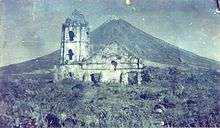
On February 1, 1814, a catastrophic eruption of Mt. Mayon partially destroyed Sawangan and buried Cagsawa, Budiao and Camalig. The parish priest of Sawangan, Fray Pedro Licup, urged the residents to transfer to Makalaya (present-day Barangay Taysan) located on the slopes of Mt. Bariw. However, many residents decided to return to the lowlands and settled in Taytay (present-day Barangay Bagumbayan).
Other survivors opted to return to the original location of Sawangan and established Binanuahan (Banuang Gurang) despite a decree by the Gobierno Superior signed on October 1, 1829, which prohibited the establishment of new towns.[26] The new settlement in Taytay grew larger and eventually became a township. Binanuahan was declared a visita or tributary of Taytay and the combined town became known as Albay Nuevo.[27]
In 1839, the settlers in Taytay started to erect a stone church designed by Gobernadorcillo Don Jose Ma. de Peñaranda, an architect, in consultation with Fray Jose Yagres, OFM. The structure would become the present Cathedral of San Gregorio Magno in the Albay district. Meanwhile, those who returned to Sawangan established an ermita or chapel dedicated to the Archangel Raphael, whom they adopted as patron saint. This became the present church of St. Raphael the Archangel in the Legazpi Port district.
On July 17, 1856, Ramon Montero of the Gobierno Superior de las Islas Filipinas signed a decree creating the visita of Pueblo Viejo, out of Binanuahan and the adjacent villages of Lamba, Rawis and Bigaa. In another decree, Montero named the town Legazpi, which was inaugurated on October 22 of the same year.
Port of Legazpi opened to world trade
The port of Legazpi served as anchorage for ships sailing to Nueva España (Mexico) beginning in the latter part of the 16th century. The nearby Sula Channel was used as a sanctuary by galleons during storms because of its sheltered inlet. In 1873, Legazpi was made a port of entry by a Royal Decree earlier issued in Madrid on May 18, 1872 and later promulgated by Governor Juan Alamenos y de Vivar on December 3, 1874.[26][28]
Legazpi was declared a city for the first time under the Becerra Law of 1892.[29][30][31][32] In 1894, the Spanish Minister of Ultramar promulgated a decree creating an ayuntamiento composed of the towns of Legazpi, Albay and Daraga.
Philippine revolution
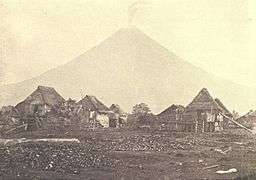
On September 22, 1898, the Civil Governor of Albay, Angel Bascaran y Federic and the Spanish residents evacuated Albay. Subsequently, a revolutionary junta was organized by Don Anacieto Solano who later turned over the command to General Vicente Lukban, General-in-chief of Operations of the revolutionary government in the southern region.[27]
American colonial era
On January 23, 1900, American forces composed of three infantry companies equipped with powerful rifles and cannon landed on the shores of Albay Gulf to conquer Legazpi. They were met by 800 revolutionary Filipino troops headed by General Jose Ignacio Paua, Col. Antero Reyes, Captain Alvaro Nepomuceno, and Policarpio Pergone who put up a strong defense of the city.[33]
The American troops, headed by Brig. Gen. W.A. Kobbe, encountered heavy resistance from the Filipino forces who gallantly engaged them in a bloody fight on San Rafael Bridge that resulted in the death of 172 Filipinos including Reyes, who used only bolos. Another 12 Filipinos were injured while the American forces suffered only 12 injured infantrymen.[33] To commemorate the valiant efforts of the revolutionary troops, a monument was built on the site of the former San Rafael Bridge. The swampy area where the bridge was located was reclaimed during the early 20th century and is now the intersection of Rizal Street and Quezon Avenue.
Following their occupation of the city in 1900, the American colonizers cancelled Legazpi's city status. In 1908, after the war's conclusion, the Americans split Legazpi into two separate towns, Legazpi and Albay, which became the provincial capital of Albay. In 1922, the town of Daraga was further split from the then municipality of Albay.
World War II

On December 12, 1941, a few days after the attack on Pearl Harbor, Legazpi was occupied by forces of the Imperial Japanese Army, the purpose of which was to obtain control of local airstrips which could be used as forward bases by fighter aircraft for operations in central Luzon. Throughout the Japanese occupation, resistance by Bicolano and local troops of the Philippine Commonwealth Army continued in the hills and mountains south of Legazpi. In January 1945, American and Filipino liberation forces, supported by Bicolano guerrillas, liberated Legazpi. However, the city suffered extensive aerial bombardment from US aircraft and many old buildings were destroyed including the old St. Raphael church and the Academia de Sta. Ines campus.
Independent Philippines
Legazpi became a city for the second time on July 18, 1948, when Daraga and Legazpi were combined to constitute its territory under Republic Act No. 306;[34] at that time, President Elpidio Quirino appointed Jose R. Arboleda[35] as the first City Mayor.[36] But on June 8, 1954, Republic Act No. 993 was approved, recreating the two towns (Daraga and Legazpi) and the city was dissolved.[37]
Finally, on June 12, 1959, Legazpi became a city for the third time under Republic Act no. 2234.[38] Amendments were introduced under R.A. 5525.[39] Presidential Decree 125 issued on February 23, 1973, declared the town of Daraga as part of the territorial jurisdiction of the city.[40][41] This decree, however, was not implemented with the onset of the Integrated Reorganization Plan, which involved the restructuring of local governments.
On September 24, 1972, then President Ferdinand Marcos designated Legazpi as the administrative center of Bicol Region through the Integrated Reorganization Plan of 1972, the implementing framework of Presidential Decree No. 1.[42][43]
Pope John Paul II visited Legazpi on February 21, 1981 during his first apostolic journey to the Philippines.[44][45] Aside from Manila where the beatification of St. Lorenzo Ruiz was held, the Pope also visited Baguio, Bacolod, Iloilo, Bataan, Cebu, and Davao.[46] The Pope held a mass dedicated to farmers at the St. Gregory the Great Cathedral.[47]
Geography

Legazpi is on the eastern portion of the province of Albay bounded on the north by the municipality of Sto. Domingo, on the east by the Albay Gulf, on the west by the municipality of Daraga, and on the south by the municipalities of Manito, Albay and Pilar and Castilla, Sorsogon. The city is located 527 kilometres (327 mi) south of Manla.
From north to south, the city spans approximately 29 kilometers; from east to west, the narrowest portion is about 3 kilometers (urban district) while the widest is about 15 kilometers (southeast area).[48] Legazpi has a total land area of 20,437 hectares, 90 percent of which is classified as rural (18,431.66 hectares) while 10 percent is classified as urban (2,005.39 hectares).[49]
Legazpi's topography is generally plain on the northeastern areas, with slopes ranging from five to fifteen degrees. The southern areas have mostly rolling to hilly terrain. In the city's coastal areas, the terrain varies from plain (north) to hilly (south).[50] Legazpi is criss-crossed by several rivers including the Tibu, Macabalo and Yawa rivers with a number of swampy areas, particularly in the urban district. To mitigate flooding in these low-lying areas, the local government has built an urban drainage and flood control system consisting of dikes, canals, sea walls and three pumping stations located in Barangays San Roque, Bay-Bay and Victory Village.[51][52]
Climate
Legazpi City features a tropical rainforest climate with copious amount of rainfall throughout the year. Legazpi has noticeably wetter and drier periods of the year. However, the city’s driest month, April, still sees on average of over 150 millimetres (5.9 in) of precipitation per year. Similar to many other cities with this climate, temperatures are relatively constant throughout the course of the year, with a mean annual average of 26.9 °C (80.4 °F).[53] The coolest month is January with a daily mean of 25.3 °C (77.5 °F) and the hottest months are jointly May and June with a daily mean of 28.1 °C (82.6 °F). The all-time record high temperature was 37.7 °C (99.9 °F) on May 27, 1968, and the all-time record low temperature was 13.9 °C (57.0 °F) on February 28, 1971.[53]
| Climate data for Legazpi | |||||||||||||
|---|---|---|---|---|---|---|---|---|---|---|---|---|---|
| Month | Jan | Feb | Mar | Apr | May | Jun | Jul | Aug | Sep | Oct | Nov | Dec | Year |
| Record high °C (°F) | 32.7 (90.9) |
33.7 (92.7) |
35 (95) |
36.5 (97.7) |
37.7 (99.9) |
37.6 (99.7) |
36.6 (97.9) |
36.9 (98.4) |
36 (97) |
35.3 (95.5) |
34.4 (93.9) |
33.2 (91.8) |
37.7 (99.9) |
| Average high °C (°F) | 28.6 (83.5) |
29.1 (84.4) |
30.0 (86) |
31.3 (88.3) |
32.3 (90.1) |
32.0 (89.6) |
31.5 (88.7) |
31.6 (88.9) |
31.5 (88.7) |
31.0 (87.8) |
30.1 (86.2) |
29.0 (84.2) |
30.7 (87.3) |
| Average low °C (°F) | 22.4 (72.3) |
22.2 (72) |
23.2 (73.8) |
24.2 (75.6) |
24.8 (76.6) |
24.5 (76.1) |
24.2 (75.6) |
24.3 (75.7) |
24.1 (75.4) |
23.8 (74.8) |
23.7 (74.7) |
23.7 (74.7) |
23.2 (73.8) |
| Record low °C (°F) | 16.7 (62.1) |
13.9 (57) |
17 (63) |
16.7 (62.1) |
17.1 (62.8) |
18.9 (66) |
15.8 (60.4) |
19.4 (66.9) |
19.0 (66.2) |
17.2 (63) |
17.9 (64.2) |
16.7 (62.1) |
13.9 (57) |
| Average rainfall mm (inches) | 296.9 (11.689) |
195.6 (7.701) |
192.6 (7.583) |
151.2 (5.953) |
181.3 (7.138) |
240.9 (9.484) |
239.4 (9.425) |
178.3 (7.02) |
216.3 (8.516) |
264.0 (10.394) |
484.6 (19.079) |
458.6 (18.055) |
3,099.7 (122.035) |
| Average rainy days (≥ 1.0 mm) | 19 | 15 | 15 | 15 | 14 | 16 | 17 | 16 | 17 | 20 | 22 | 22 | 208 |
| Average relative humidity (%) | 79 | 74 | 72 | 68 | 67 | 68 | 78 | 78 | 80 | 81 | 84 | 84 | 70 |
| Mean monthly sunshine hours | 155 | 168 | 217 | 240 | 279 | 210 | 186 | 186 | 186 | 180 | 157 | 149 | 2,313 |
| Source #1: PAGASA[54] | |||||||||||||
| Source #2: World Climate Guide (sunshine data).[55] | |||||||||||||
Disaster Risk Reduction
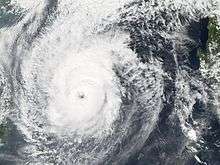
Because of its geographical location on the eastern coast of the Philippines within the Pacific Ring of Fire, Legazpi is vulnerable to typhoons, volcanic eruptions and sea level rise. To mitigate the effects of climate change and improve the city's resilience against disasters, the city government has adopted a disaster risk reduction and climate change adaptation strategy.[56] The City Government of Legazpi was recognized by the National Disaster Risk Reduction Management Council (NDRRMC) as a model locality in implementing risk reduction management practices in the Philippines.[57]
On the provincial level, Albay has institutionalized disaster preparedness and disaster response by creating the Albay Public Safety and Emergency Management Office (APSEMO) in 1995.[58] The APSEMO is tasked to design and implement a disaster risk management and reduction program. Its main objective is to develop more pro-active and disaster resilient communities.[58] Specific disaster preparedness strategies in Albay and Legazpi include preemptive evacuation,[59] 'zero casualty' policy,[60][61] re-planning of the city's land use,[62] mangrove reforestation,[63] and the establishment of the Climate Change Academy as a training center for disaster risk management, evaluation of climate risk hazards and adaptive capabilities, planning, and programming.[64][65]
Demographics
| Population census of Legazpi City | |||||||||||||||||||||||||
|---|---|---|---|---|---|---|---|---|---|---|---|---|---|---|---|---|---|---|---|---|---|---|---|---|---|
|
| ||||||||||||||||||||||||
| Source: National Statistics Office[6][66][67] | |||||||||||||||||||||||||
In the 2015 census, the population of Legazpi was 196,639 people,[6] with a density of 1,300 inhabitants per square kilometre or 3,400 inhabitants per square mile.
In the 2010 Census, Legazpi had a population of 182,201 with an average annual population growth of 1.86% between 2000 and 2007. About 58 percent of the city's population or 105,853 live in areas classified as urban while 42 percent or 76,348 live in rural areas. The city has a population density of 9 people per hectare (54 people per hectare in urban areas and 4 people per hectare in rural areas). Daytime population in Legazpi is estimated to reach 350,000 due to the daily influx of students, workers, businessmen and tourists.[68]
Legazpi is the most populous city in the province of Albay and in the Bicol Region. It comprises 14.8% of the total population of Albay.[69] Languages spoken include Bikol (specifically Central Bikol Language), English, Filipino and Chinese.[70]
Religion

Roman Catholicism is the predominant religion in the city. Other religious denominations include Iglesia ni Cristo, Protestant churches such as Baptist, Methodist, Evangelical Christians, Seventh-day Adventist Church, Church of Jesus Christ of Latter Day Saints, Jehovah's Witnesses, and Islam. The city is the ecclesiastical seat of the Roman Catholic Diocese of Legazpi.
Culture
Festivals
The Ibalong Festival is a non-religious festival held annually each August. The festival celebrates the epic-fragment Ibalong, which narrates the exploits of three legendary heroes of Ibalon or Ancient Bikol: Baltog, Handyong, and Bantong. It was first held in October 1992. Yearly activities include the Ibalong Street Presentation, trade fairs, bazaars and weekend markets, Mutya ng Ibalong Pageant, and sports-related events such as the annual Mt. Mayon Triathlon.[71]

The Daragang Magayon Festival is a month-long annual festival celebrating Mt. Mayon. It is held in April in the entire province of Albay with most of the activities held in Legazpi City. The name comes from the Bikol word 'magayon', which means beautiful, from which the name of Mt. Mayon is derived. The festival features agricultural products display and trade fairs, culinary shows, cultural events, street parades, photo/arts exhibits, and sports events.[72]
During the Christmas season, the Karangahan Albay Green Christmas is held to emphasis on safe and environment-friendly celebration of the Yuletide season. First held in 2009, the festival runs from December 1 to 31.[73][74][75][76]
Having different patron saints, the city's two districts have different fiestas. Legazpi port district fiesta is held every October 24 in honor of St. Raphael the Archangel. Yearly activities include street parade and a maritime procession. The Albay district fiesta is held every September 3, in honor of St. Gregory the Great; it is usually declared a local non-working holiday.[77][78] There are several local festivals held in the city's barangays including Sto. Cristo Festival in Barangay Dap-Dap, Bankero Festival in Barangay San Roque, Biga Festival in Barangay Bigaa, Banua Festival in Barangay Binanuahan, Peñafrancia Festival in Barangay Sabang and Hikot Festival in Barangay Victory Village.[79]
Economy

Legazpi City is a major economic hub in the Bicol Region. Economic activities in the city include agriculture, wholesale and retail trade, services, manufacturing and mining. Major sources of income include rice, root crops, and coconut. The city exports coconut oil, copra cake, perlite, and abaca products.[70][80] The city also has a fast-growing tourism industry with focus on adventure tourism.[81][82] The city government is promoting Legazpi as an ideal location for ICT-BPO businesses. In 2014, Legazpi's locally generated income reached Php338.2 million, with total income (including IRA) at Php711.1 million.[70][83] In the same year, Legazpi ranked first among cities in Bicol in terms of tax collection efficiency.[84][85]
Trade and industry

There were 5,055 business establishments in Legazpi as of 2014.[86] Most of these are located in the city's central business district, the Legazpi Port District. Landco Business Park, the first master-planned commercial business district in the Bicol Region, opened in 2001.[87] Thriving industries in Legazpi include coconut oil milling and production (Legaspi Oil Company - CIIF),[88] construction aggregate quarrying,[89] 'pinukpok' (abaca fabric) production in Brgy. Banquerohan,[90][91] and organic fertilizer manufacturing.[92]
To further boost the local economy, the city government is promoting the establishment of information technology (IT) parks and industrial estates such as the Embarcadero IT Park in Brgy. Victory Village, City Light Industrial Park (CLIP) in Brgy. Bogtong, Legazpi City Special Economic Zone in Brgy. Banquerohan, Bicol Regional Agro-Industrial Center (BRAIC) and First Legazpi Industrial Estate, both in Brgy. Homapon.[93][94]
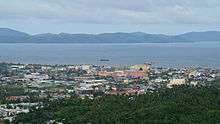
The city is also home to a number of retail establishments. Liberty Commercial Center, Inc. (LCC), a homegrown Albayano company established in nearby Tabaco City in 1945, operates a major mall (LCC Mall Legazpi), three supermarkets and five Expressmarts (grocery stores) in the city.[95] Another notable mall is Pacific Mall Legazpi, the first full-sized mall in Bicol. Other malls in Legazpi include Embarcadero de Legazpi, A. Bichara Silverscreens and Entertainment Center, 101 Shopping Mall, Yashano Mall and Gregorian Mall. The city has also attracted investments from national retail chains including Metro Gaisano, SM Savemore, Robinsons Supermarket, Puregold and 7-Eleven. Ayala Malls [96][97][98] recently opened its Ayala Malls Legazpi - Liberty City Center. Meanwhile, according to city officials, SM Supermalls[99][100] is looking at possible sites in the city to open SM City Legazpi, the second SM Supermall in Bicol. The city has two public markets: Legazpi City Public Market, a recipient of the 'Huwarang Palengke Award' in 2006,[101] and Old Albay Public Market.[102][103] The Ibalong Pasalubong Center has shops selling souvenirs and local handicrafts.[104]
Banking and finance
As of June 30, 2015, Legazpi had a total of 42 banks, with volume of bank deposits at Php24.9 billion.[105] Legazpi Savings Bank, a thrift bank based in the city with eleven branches around the Bicol Region, was acquired by Robinsons Bank in 2012.[106] The Bangko Sentral ng Pilipinas also has a branch in the city, along Rizal Street in Barangay Cabangan.
Business process outsourcing

Legazpi is recognized as one of the 'next wave cities' for business process outsourcing (BPO).[107][108] The next wave cities are a list of ICT hubs beyond Metro Manila identified by the Information Technology and Business Process Association of the Philippines and the Department of Science and Technology, based on a set of criteria such as worker supply, telecom infrastructure and other factors needed to sustain the BPO industry.[109] Legazpi is aiming to attract more BPO firms to put up offices in the city.[110][111] As of 2015, BPO companies in Legazpi include One Half Philippines.[112]
The city currently has one IT park, the Embarcadero IT Park,[113] which offers about 8,000 call center seats that could provide jobs to some 24,000 agents in three shifts. Pioneering the business in the city is the Incubation Center of Southern Luzon Technological College Foundation Inc. (SLTCFI), which is an extension of Embarcadero’s P1.8-billion IT Park, the very first IT ecozone in the Bicol region inaugurated in July 2009.[2] As of 2015, the biggest locator in Embarcadero IT Park is Sutherland Global Services.[114][115]
Housing
There are 141 residential subdivisions and housing sites (132 privately owned, 9 government owned) in Legazpi.[70] National and local real estate developers have also invested in the city. These include Vista Land (Camella Legazpi),[116] Deca Homes,[117] and Sunwestville Realty and Development Corp. (Eco Homes Bayshores Condominium).[118] In 2015, Taft Property Ventures Development Corp., the real estate arm of Gaisano Group, announced that it is building a condominium in Legazpi.[119][120]
Tourism
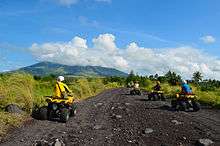
Located on the southern foothills of the scenic Mount Mayon, the city has a flourishing tourism industry. The province of Albay, whose center of trade and commerce is in the city, recorded a 66 percent growth rate in tourist arrivals for 2013.[121] In the same year, the city had a total of 263,568 foreign tourist arrivals, the most in the region.[122] In 2014, the city welcomed 666,210 tourists, an increase of 15 percent from the previous year.[123] including Chinese tourists who arrived at the city via direct chartered flights from Xiamen, China.[124][125][126] For 2015, Legazpi aims to reach its target of 900,000 tourist arrivals.[127][128]
Legazpi has the tourism tagline the "City of Fun and Adventure",[129][130] with a number of adventure tourism activities within the city including riding an ATV around Mt. Mayon, zip-lining, skydiving, scuba diving, and water sports.[131][132][133][134][135][136] In an ATV adventure to Mt. Mayon, tourists drive an all-terrain vehicle over rough trails, including a dry riverbed, leading to the volcano's lower slopes where hardened lava rock from previous eruptions are deposited. The activity was featured in reality shows The Amazing Race Asia 4 in 2010 and The Amazing Race Philippines 1 in 2012.[137] American actor Zac Efron visited Legazpi in October 2012 and drove an ATV around Mayon.[138][139]
Hiking and climbing Mt. Mayon is allowed during peaceful spells but was prohibited following a phreatic explosion with casualties in May 2013.[140][141] As part of its efforts to promote sports and adventure tourism, the city hosts annual sporting events such as Mt. Mayon Triathlon, Mayon 360 Ultramarathon and XTERRA Triathlon. The city also serves as a jump-off point to other adventure activities nearby including river rafting and waterfalls exploration in Malinao,[142][143] spelunking in Camalig,[144] island hopping in Bacacay,[145][146] skimboarding in Sto. Domingo,[147] and whale shark interaction in Donsol, Sorsogon.
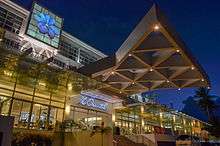
The city is home to 56 hotels and 110 bars and restaurants.[70] As of 2014, Legazpi had a total of 1,547 hotel rooms.[148] Among the notable hotels in the city is The Oriental Legazpi. Located in the hills of Taysan, it offers a panoramic view of the city, the Albay Gulf and Mt. Mayon.[149] It served as the venue of the joint conference meetings of the United Nations World Tourism Organization (UNWTO) and the Association of South East Asian Nations (ASEAN) from May 14 to 20, 2014[150] as well as the PATA New Tourism Frontiers Forum 2015.[151]
Legazpi is also aiming to be one of the top five convention destinations in Luzon by 2020.[123] The city has two public indoor arenas that can also serve as convention centers: Ibalong Centrum for Recreation (capacity: 7,000 persons)[152] and Albay Astrodome (capacity: 5,000 persons) The Albay Astrodome was used as the venue for the Big Night of Pinoy Big Brother: 737 on November 7–8, 2015.[153] The city government is also planning to build the Legazpi City Convention Center.[154] There are also several privately owned and hotel-based convention facilities such as the Casablanca Convention Hall (capacity: 1,000 persons),[155] The Oriental Grand Ballroom (capacity: 750 persons),[156] and Top of St. Ellis (capacity: 300 persons).[157] In 2015, Legazpi hosted 51 national and international conventions.[158]
Foreign trade
With a total trade value of US$129,423,764, the port of Legazpi is the leading port for exports in the entire Bicol Region for 2013.[159] Among the 17 port districts in the country, Legazpi is one of only five port districts that posted positive collection goals for January to April 2015.[160]
Infrastructure
Transportation
Legazpi is considered as the gateway to Bicol because of its relative proximity to the provinces of the region due to its geographical location.[161][162] With an airport, seaport, bus and rail terminals, the city is accessible to all modes of transportation.
Air
The city is served by Legazpi Airport (IATA: LGP, ICAO: RPLP). It is the busiest domestic airport in mainland Southern Luzon[163] and was ranked 15th busiest in the country in 2012, with total passenger traffic of 578,762. The Legazpi Airport has a runway length of 2,280 metres (7,480 ft) and is capable of handling international aircraft. As of 2015, Cebu Pacific Air flies thrice daily between Manila and Legazpi and 4x weekly between Cebu and Legazpi. Philippine Airlines has two daily flights between Manila and Legazpi. Cebgo (formerly Tigerair Philippines), a subsidiary of Cebu Pacific Air, has one daily flight between Manila and Legazpi.
In 2015, the Legazpi Airport was renovated to expand and improve the passenger terminal, add separate arrival and pre-departure areas for domestic and international chartered flights, and provide office space for the Bureau of Immigration, Customs and Human/Plant Quarantine and the Philippine Drug Enforcement Agency.[164] The Legazpi Airport is set to be replaced by the Bicol International Airport currently under construction in Brgy. Alobo, Daraga, fifteen kilometers away from the current airport.
Land
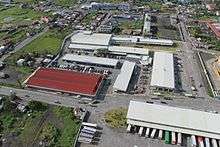

Legazpi is accessible by land transport. Several buses ply the route between Manila with stops in neighboring provinces.[165] The city has an award-winning integrated bus and public utility vehicle terminal called Legazpi Grand Central Terminal, a public-private partnership project.[166] Buses and public utility vehicles also have regular trips between Legazpi and neighboring cities. The city is also served by Legazpi railway station, the southernmost terminus of the Philippine National Railways (PNR). Plans are underway to revive rail transport between Manila and Legazpi.[167] As of 2015, the PNR has started commuter rail service between Legazpi and Naga City.[168] Modes of public transport within the city include jeepneys, tricycles, taxicabs and pedicabs. The PNR Legazpi station was also the terminus of LG - TA branch line (Tabaco-Legazpi) and the Legazpi Division Line.
Sea

The port of Legazpi is classified as a national sub-port of entry catering to domestic and foreign cargo vessels.[169] Its modern-day port, which was built by the engineering firm Pedro Siochi and Company during the era of President Quezon, played a great role in the liberation of Manila in 1945. As of 2015, regular passenger trips from the port are between Legazpi and the island municipality of Rapu-Rapu and coastal villages of Bacon District, Sorsogon City. The city government has proposed the construction of an international cruise ship terminal under public-private partnership.[170] The proposed passenger cruise terminal has received approval from the Department of Tourism and the Tourism Infrastructure and Enterprise Zone Authority (TIEZA).[170][171]
Waste Management
The city government operates a 1.5 hectare sanitary landfill in Brgy. Banquerohan. Opened in 2011 through a grant from the Spanish government’s Agencia Espanola Cooperacion Internacional para el Desarollo (AECID),[172] the sanitary landfill has two cells that will contain the city's non-recyclable waste.[173] In 2010, Legazpi implemented a solid waste management program with emphasis on reduction of waste in the household and business establishment level; resource recovery, recycling, and reusing at the barangay level; collection, transfer, transport and management of residual waste at the city level.[174] The city also aims to reduce plastic waste by implementing the 'plastic for rice program' wherein citizens can exchange five kilos of residual plastic waste for a kilo of rice.[175] The city government recognizes barangays that practice outstanding solid waste management.[176]
As a result of its waste management programs, the city was able to successfully reduce solid waste generated per capita per day from 0.5 kilograms in 2009 to 0.29 kilograms in 2015.[174] Meanwhile, the city is planning to build a septage and waste water treatment facility to protect its water resources.[177] A Japanese firm has also proposed an organic fertilizer manufacturing project.[178]
Flood Control
To prevent flooding in the city's main business center, the city government is building a flood control project that is envisioned to turn Legazpi into an 'all weather city'.[179] Components of the project include three pumping stations located in barangays San Roque, Baybay and Victory Village, dikes and drainage systems along the Tibu and Macabalo Rivers, and a 2.7 kilometer coastal road in barangays Pigcale, Sabang, Baybay, San Roque and Rawis that will serve as protection from storm surges.[180][181][182]
Sports
The Albay Vulcans are a Philippine rugby union and rugby league team based in Legazpi. They play in the Philippines National Rugby League Championship.
Education

Legazpi is a center of education in the Bicol Region. It is home to two universities (Bicol University and Aquinas University of Legazpi) and a number of colleges and technical-vocational schools. As of 2010, there are 63 daycare/pre-schools, 57 elementary schools and 27 secondary schools in the city.[183]
Bicol University, established in 1969 as the premier regional state and research university and the first ISO 9001:2008 certified public university in Bicol, has its main campus in Legazpi near the boundary with neighboring Daraga town. The BU Main Campus hosts the College of Education (BUCE), College of Nursing (BUCN), College of Arts and Letters (BUCAL), College of Science (BUCS), Graduate School (BUGS), Institute of Physical Education, Sports and Recreation (IPESR), College of Medicine (BUCM), Bicol University College of Education Integrated Laboratory School-Elementary Department and Bicol University College of Education Integrated Laboratory School-High School Department (BUCEILS-HS). The Bicol University Research Extension Program Center (BUREPC), the Amphitheatre and the Little Theater are also found in this campus. For school year 2015–16, BU has 27,226 enrollees.[184]
Aquinas University of Legazpi is a private Catholic University run by the Dominican Fathers/Order of Preachers. Originally founded by Don Buenaventura de Erquiaga as the Legazpi Junior Colleges in 1948, AUL became a university in 1968 when the administration of the college was passed on to the Dominicans. Aquinas University of Legazpi offers elementary, secondary, vocational, tertiary and graduate curricula.[185]
St. Agnes' Academy, established in 1912 by the Missionary Benedictine Sisters, is the oldest Catholic school in Albay and the second Benedictine school to be established in the Philippines after St. Scholastica's College Manila.[186]
Divine Word College of Legazpi is a Catholic college run by the Societas Verbi Divini (SVD) Congregation. It started as Liceo de Albay, a diocesan parochial school for boys established in 1947 by Rev. Fr. Juan Carullo, a retired Army Chaplain. In 1960, the SVD led by Fr. Joseph L. Bates took over the administration of the school and renamed it Divine Word High School. It was elevated to tertiary level as Divine Word College of Legazpi (DWCL) in 1965.[187]
Local Government

Legazpi City is governed by a mayor, vice-mayor, and ten councilors. Each city official is elected to serve for a three-year term. The representative of the Liga ng mga Barangay and the Sangguniang Kabataan also participates in the city council. The current city mayor of Legazpi is Noel Rosal, elected during the 2016 Philippine Elections. Oscar Robert H.Cristobal serves as vice-mayor[188]
Barangays
Legazpi is politically subdivided into 70 barangays.[7] The City has 45 urban barangays and 25 rural barangays.[70]
| Barangay number |
Barangay name |
Class | Population (2015)[6] |
Barangay head[189] |
|---|---|---|---|---|
| 1 | Em's Barrio | Urban | 3,725 | Adronico D. Geraldino |
| 2 | Em's Barrio (South) | Urban | 1,820 | Echedita M. Salcedo |
| 3 | Em's Barrio (East) | Urban | 900 | Jose P. Pispis |
| 4 | Sagpon | Urban | 953 | Felixberto S. Cordornez, Jr. |
| 5 | Sagmin | Urban | 1,375 | Alberto R. Murilla |
| 6 | Bañadero | Urban | 1,390 | Alex Locsin |
| 7 | Baño | Urban | 645 | Domingo Pasano, Jr. |
| 8 | Bagumbayan | Urban | 3,400 | Gil L. Alianza |
| 9 | Pinaric | Urban | 1,493 | Roy A. Nanoz |
| 10 | Cabugao | Urban | 547 | Victor Lapasaran |
| 11 | Maoyod | Urban | 1,110 | Manuel A. Omnes |
| 12 | Tula-Tula | Urban | 2,586 | Miguelito A. Barcoma |
| 13 | Ilawod West Pob. (Ilawod 1) | Urban | 721 | Marilou Baltazar |
| 14 | Ilawod Pob. (Ilawod 2) | Urban | 854 | Susana M. Contacto |
| 15 | Ilawod East Pob. (Ilawod 3) | Urban | 2,879 | Herlim Azotea |
| 16 | Kawit-East Washington Drive | Urban | 5,372 | Jonathan Rodenas |
| 17 | Rizal St. - Ilawod | Urban | 2,048 | Lina Chan |
| 18 | Cabañgan (West) | Urban | 3,856 | Leoncio Song |
| 19 | Cabañgan | Urban | 1,427 | Roger H. Esquivel |
| 20 | Cabañgan (East) | Urban | 641 | Nimfa Bolanos |
| 21 | Binanuahan (West) | Urban | 917 | Ma. Theresa F. Abiera |
| 22 | Binanuahan (East) | Urban | 1,619 | Napoleon Cardel |
| 23 | Imperial Court | Urban | 746 | Gina M. Samaupan |
| 24 | Rizal | Urban | 2,695 | Ricardo Abunda |
| 25 | Lapu-Lapu | Urban | 1,398 | Gemma M. Espiritu |
| 26 | Dinagaan | Urban | 798 | Edwin T. Alzaga |
| 27 | Victory Village (South) | Urban | 1,418 | Joie Bahoy |
| 28 | Victory Village (North) | Urban | 2,399 | Antonio Loveriza |
| 29 | Sabang | Urban | 1,656 | Ismael G. Santillan |
| 30 | Pigcale | Urban | 1,688 | Fernando Lopez |
| 31 | Centro Baybay | Urban | 1,415 | Diosdado Empig |
| 32 | San Roque | Urban | 5,632 | Joselito G. Martinez |
| 33 | PNR - Peñaranda St. - Iraya | Urban | 2,773 | Beatriz N. Toledo |
| 34 | Oro Site - Magallanes St. | Urban | 1,633 | Joseph Philip L. Lee |
| 35 | Tinago | Urban | 375 | Cyril Sayco |
| 36 | Kapantawan | Urban | 644 | Evelyn B. Brizuela |
| 37 | Bitano | Urban | 8,559 | Joel M. Balinis |
| 38 | Gogon | Urban | 5,752 | Perfecto Nacion |
| 39 | Bonot | Urban | 3,521 | Henry G. Asejo |
| 40 | Cruzada | Urban | 5,853 | Edsil L. Llaguno |
| 41 | Bogtong | Urban | 4,753 | Armando Toledo |
| 42 | Rawis | Urban | 8,868 | Jojo Orosco |
| 43 | Tamaoyan | Rural | 1,642 | Sylvia Del Agua |
| 44 | Pawa | Rural | 3,469 | Roger M. Nunez |
| 45 | Dita | Rural | 1,791 | Alfredo Garbin, Sr. |
| 46 | San Joaquin | Rural | 2,260 | Tomas Abaroa |
| 47 | Arimbay | Urban | 3,753 | Rosalina O. Gervero |
| 48 | Bagong Abre | Rural | 1,627 | Diego E. Obido |
| 49 | Bigaa | Rural | 6,730 | Roberto Arienda |
| 50 | Padang | Rural | 1.653 | Manuel P. Alagaban, Sr. |
| 51 | Buyuan | Rural | 3,895 | Ernesto Perez |
| 52 | Matanag | Rural | 1,895 | Reynaldo B. Poquilla |
| 53 | Bonga | Rural | 3,503 | Michael A. Mina |
| 54 | Mabinit | Rural | 1,640 | Levy Nunez |
| 55 | Estanza | Rural | 4,237 | Roger Alteche |
| 56 | Taysan | Rural | 12,330 | Renato Valladolid |
| 57 | Dap-dap | Urban | 2,287 | Marites N. Barcelon |
| 58 | Buragwis | Urban | 4,549 | Jose Alfonso V. Ariso |
| 59 | Puro | Rural | 4,756 | Nicasio Barrios |
| 60 | Lamba | Rural | 1,352 | Mario P. Abaluado |
| 61 | Maslog | Rural | 4,796 | Nenelita C. Berjuega |
| 62 | Homapon | Rural | 4,832 | Benhur Ariola, Jr. |
| 63 | Mariawa | Rural | 1,664 | Anabelle A. Teope |
| 64 | Bagacay | Rural | 1,616 | Julian A. Ariola |
| 65 | Imalnod | Rural | 2,146 | Velentin Llaneta |
| 66 | Banquerohan | Rural | 6,976 | Efren F. Obido |
| 67 | Bariis | Rural | 1,812 | Geremias B. Leron |
| 68 | San Francisco | Rural | 2,479 | Ronald P. Aringo |
| 69 | Buenavista | Rural | 1,319 | Ester P. Ardales |
| 70 | Cagbacong | Rural | 2,776 | Leon Andes |
Health care
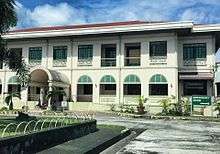
Health care institutions in Legazpi:
- Ago General Hospital
- Albay Doctors Hospital
- Albay Polyclinic
- Aquinas University Hospital
- Bicol Eye Center
- Bicol Regional Training and Teaching Hospital (BRTTH)
- Dr. Esteban V. Ante Hospital
- Estevez Memorial Hospital
- Legazpi City Hospital (under construction)
- Legazpi Eye Center
- Suncore Multispecialty and Diagnostic Clinic
- Tanchuling Hospital
Notable people
- William 'Bogs' Adornado - three-time PBA Most Valuable Player (1975, 1976, and 1981), one of the PBA's 25 Greatest Players of All-Time[190][191]
- Merlinda Bobis - contemporary Philippine-Australian writer and academic[192]
- Irene Cortes - former Associate Justice of the Supreme Court of the Philippines; first female Dean of the UP College of Law[193]
- Janelle Quintana - actress; 19th Aliw Awards Best New Female Artist nominee
- Valerie Weigmann - TV host, actress; Miss World Philippines 2014
- Miguel Solano White - track and field athlete; bronze medalist in the 400 metre hurdles at the 1936 Summer Olympics[194]
Sister cities
Local
-
 Bacolod, Negros Occidental
Bacolod, Negros Occidental -
 Bacoor, Cavite
Bacoor, Cavite -
 Masbate City, Masbate
Masbate City, Masbate -
 Sorsogon City, Sorsogon
Sorsogon City, Sorsogon -
 Castilla, Sorsogon
Castilla, Sorsogon -
 Davao City, Davao del Sur
Davao City, Davao del Sur
International
-
 Chōshi, Japan
Chōshi, Japan
Gallery
 Legazpi City aerial view
Legazpi City aerial view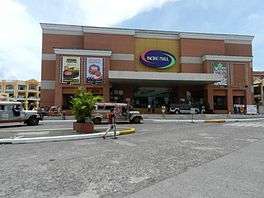 Pacific Mall Legazpi
Pacific Mall Legazpi Kapuntukan Hill and Legazpi Boulevard at night
Kapuntukan Hill and Legazpi Boulevard at night- Albay Park and Wildlife
 Embarcadero de Legazpi
Embarcadero de Legazpi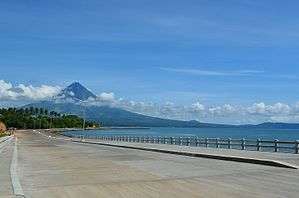 Legazpi Boulevard
Legazpi Boulevard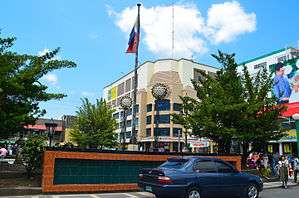 Plaza Rizal
Plaza Rizal Legazpi view from Ligñon Hill
Legazpi view from Ligñon Hill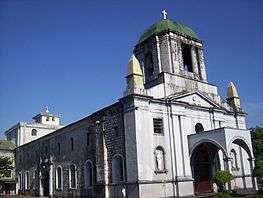 St. Gregory the Great Cathedral, Legazpi City
St. Gregory the Great Cathedral, Legazpi City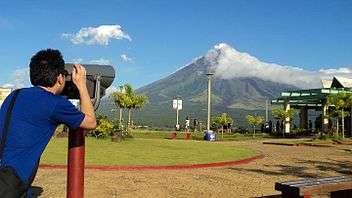 Ligñon Hill Nature Park
Ligñon Hill Nature Park
See also
References
- ↑ "The City Tagline". City Government of Legazpi. Retrieved 2016-09-01.
- 1 2 3 "Archived copy". Archived from the original on 2014-08-26. Retrieved 2014-08-23.
- ↑ "NSCB-RD5 - Overview of the Region". Nscb.gov.ph. 2010-05-01. Retrieved 2016-04-21.
- ↑ "Official City/Municipal 2013 Election Results". Intramuros, Manila, Philippines: Commission on Elections (COMELEC). 11 September 2013. Retrieved 2013-11-27.
- ↑ "Province: Albay". PSGC Interactive. Makati City, Philippines: National Statistical Coordination Board. Retrieved 2012-05-15.
- 1 2 3 4 5 "Region V (BICOL REGION)". Census of Population (2015): Total Population by Province, City, Municipality and Barangay (Report). PSA. Retrieved 20 June 2016.
- 1 2 "Municipality/City: LEGAZPI CITY (Capital)". Philippine Standard Geographic Code Interactive. Retrieved on 2012-05-17.
- ↑ "DILG Regional Office No. 5 Directory". Bicol Region Official website; retrieved 2012-05-22.
- ↑ "Archived copy". Archived from the original on 2010-04-16. Retrieved 2010-03-18.
- ↑ "Philippines News Agency: Legazpi expects more investments from SM By Danny O. Calleja". Pnabicol.blogspot.com. 2013-06-07. Retrieved 2016-04-21.
- ↑ "Discover Legazpi". wowlegazpi.com. Retrieved 2014-03-26.
- ↑ Flores, Helen (October 27, 2007). "Bacolod named most business-friendly city". Retrieved 2015-10-13.
- ↑ "Legazpi bags AIM Entrepreneur's Award for Honesty and Transparency | Visit Legazpi!". Visit Legazpi!. Retrieved 2015-10-13.
- ↑ "Iloilo, Legazpi, Cebu adjudged country's most livable city". BusinessMirror. Retrieved 2016-04-21.
- ↑ "Livable city award affirms Legazpi's excellence as APEC summit host | LEGAZPI CITY". legazpi.gov.ph. Retrieved 2015-10-13.
- ↑ "NCC unveils most competitive cities and municipalities; Recognizes LGU's crucial role in national competitiveness | National Competitiveness Council". www.competitive.org.ph. Retrieved 2016-07-21.
- ↑ "Department of Tourism - The Philippines Ultimate Travel Guide for Tourist". www.visitmyphilippines.com. Retrieved 2015-10-18.
- 1 2 3 Newson, Linda A. (2009-01-01). Conquest and Pestilence in the Early Spanish Philippines. University of Hawaii Press. ISBN 9780824832728.
- ↑ Tan, Samuel K. (2008-01-01). A History of the Philippines. UP Press. ISBN 9789715425681.
- ↑ "Philippine Daily Inquirer - Google News Archive Search". news.google.com. Retrieved 2015-10-18.
- ↑ "There are only three declared National... - Joey Constant Kindness Salceda | Facebook". tl-ph.facebook.com. Retrieved 2015-10-18.
- ↑ "The National Museum of the Philippines Declared 36 Archaeological Materials from prehistoric sites". CNN iReport. Retrieved 2015-10-18.
- ↑ "History of Legazpi City and other Albay towns - Camperspoint Philippines". www.camperspoint.com. Retrieved 2015-10-18.
- ↑ "History". Province of Albay. Retrieved 2015-10-18.
- ↑ "Travel Albay » History of Albay". travelalbay.com. Retrieved 2015-10-18.
- 1 2 3 4 "Saint Gregory the Great Cathedral". Digital Tourism. Retrieved 2015-10-13.
- 1 2 "Department of Tourism - The Philippines Ultimate Travel Guide for Tourist". www.visitmyphilippines.com. Retrieved 2015-10-13.
- ↑ "St. Raphael The Archangel Church". Digital Tourism. Retrieved 2015-10-13.
- ↑ "Quick Facts on Legazpi City". NSO Bicol Albay Tourism Weblink.
- ↑ Espinas, Merito B. (1996-01-01). Ibálong: the Bikol folk epic-fragment : English and Bikol translation, views and comments. M.C. Espinas. ISBN 9789715060684.
- ↑ Pacho, Arturo G.; Panganiban, Elena M. (1974-01-01). Urban Development Planning in Four Philippine Cities: A Joint Project of the U.P. Local Government Center and the National Economic and Development Authority. College of Public Administration, University of the Philippines.
- ↑ Sabio, Rodolfo C. (1978-01-01). The Case of Annexation of Daraga to Legazpi City. Research & Publications Program, College of Public Administration, University of the Philippines.
- 1 2 "115 years ago | Legazpi City commemorates 1900 battle against American invaders". InterAksyon.com. Retrieved 2015-10-13.
- ↑ "PHILIPPINE LAWS, STATUTES AND CODES - CHAN ROBLES VIRTUAL LAW LIBRARY". www.chanrobles.com. Retrieved 2015-10-13.
- ↑ "The Families of Old Bicol". remembrance of things awry. Retrieved 2015-10-09.
- ↑ "An Act Creating the City of Legaspi (Charter of the City of Legaspi)". LawPH.com. Retrieved 2011-04-09.
- ↑ "An Act Recreating the Municipalities of Legaspi and Daraga in the Province of Albay". LawPH.com. Retrieved 2011-04-09.
- ↑ Republic Act No. 2234 The LawPhil Project (http://www.lawphil.net). Retrieved on 2013-08-31.
- ↑ Republic Act No. 5525 Chan Robles (http://www.chanrobles.com). Retrieved on 2013-08-31.
- ↑ "Archived copy". Archived from the original on 2013-02-21. Retrieved 2012-05-17.
- ↑ "Presidential Decree No. 125 : PHILIPPINE LAWS, STATUTES and CODES : CHAN ROBLES VIRTUAL LAW LIBRARY". Chanrobles.com. Retrieved 2016-04-21.
- ↑ "Philippines Provinces". Statoids.com. Retrieved 2016-04-21.
- ↑ "P.D. No. 1 1972". Lawphil.net. Retrieved 2016-04-21.
- ↑ "Pope John Paul II's visits to PH | Inquirer Global Nation". Globalnation.inquirer.net. Retrieved 2016-04-21.
- ↑ "Albayanos pay homage to Pope John Paul II's relics in Albay Cathedral". ptvnews. Retrieved 2015-10-20.
- ↑ "REWIND: Looking back at previous papal visits in the Philippines". GMA News Online. Retrieved 2015-10-20.
- ↑ "21 February 1981: Mass for farmers in Legazpi City, Philippines | John Paul II". w2.vatican.va. Retrieved 2015-10-20.
- ↑ "legazpi". www.lchr.org. Retrieved 2015-10-13.
- ↑ "Legazpi City Profile [PDF]" (PDF).
- ↑ "Bicol Situationer". Scribd. Retrieved 2015-10-13.
- ↑ "Ongoing works on Legazpi's urban drainage system impress DPWH chief | LEGAZPI CITY". legazpi.gov.ph. Retrieved 2015-10-13.
- ↑ "Legazpi City - Ulat sa Bayan 2012: Ongoing projects -... | Facebook". Facebook.com. Retrieved 2015-10-13.
- 1 2 "Climate Change Scenario for the Philippines". Philippine Atmospheric, Geophysical and Astronomical Services Administration (PAGASA). Retrieved 2014-03-26.
- ↑ "Forecasters Handbook for the Philippine Islands and Surrounding Waters". The Naval Research Laboratory. Retrieved 2012-08-11.
- ↑ "Legaspi Climate Guide, Philippines | World Climate Guide". worldclimateguide.co.uk. Retrieved 2016-11-17.
- ↑ "Rosal bares Legazpi City's DRR strategies to disaster officers of other regions | LEGAZPI CITY". legazpi.gov.ph. Retrieved 2015-10-17.
- ↑ "City sweeps 2 top national awards in Gawad Kalasag 2013 | LEGAZPI CITY". legazpi.gov.ph. Retrieved 2015-10-17.
- 1 2 "Albay Government ensures disaster prepared communities - ALAGAD Party-List". www.alagad.com.ph. Retrieved 2015-10-17.
- ↑ "Preemptive Evacuation: Emerging Typologies, Evolving Practices [PDF]" (PDF).
- ↑ "Albay model: Zero casualty". newsinfo.inquirer.net. Retrieved 2015-10-17.
- ↑ "PNoy commends Albay's zero casualty in Sona". The Standard. Retrieved 2015-10-17.
- ↑ "Legazpi taps Palafox for city re-planning towards more investments | LEGAZPI CITY". legazpi.gov.ph. Retrieved 2015-10-17.
- ↑ "In the Philippines, a model for confronting climate change and nearly every disaster you can think of | Citiscope". citiscope.org. Retrieved 2015-10-17.
- ↑ "President Aquino Inaugurates Climate Change Academy of Albay | Embassy of the Philippines". www.philembassy.no. Retrieved 2015-10-17.
- ↑ "Adapting to Climate Change: Strategies of Albay, Philippines". climatechange.searca.org. Retrieved 2015-10-17.
- ↑ "Total Population by Province, City, Municipality and Barangay: as of May 1, 2010" (PDF). 2010 Census of Population and Housing. National Statistics Office. Retrieved 2012-05-15.
- ↑ "Province of Albay". Municipality Population Data. LWUA Research Division. Retrieved 2013-08-16.
- ↑ "10 Galing Pook awardees brighten up government service". InterAksyon.com. Retrieved 2015-10-15.
- ↑ "Albay's Total Population Increased by Aalmost a Hundred Thousand | Philippine Statistics Authority". psa.gov.ph. Retrieved 2015-10-10.
- 1 2 3 4 5 6 "City History and Profile | LEGAZPI CITY". legazpi.gov.ph. Retrieved 2015-10-15.
- ↑ "Philippines News Agency: Legazpi's 24th Ibalong Festival opens Aug. 8 By Danny O. Calleja". Philippines News Agency. 2015-08-06. Retrieved 2015-10-13.
- ↑ "Calendar of Festivities : Magayon Festival ("Festival of Festivals Showdown)". Tourism.gov.ph. Retrieved 2016-04-21.
- ↑ "PASTORES: A Uniquely Bicolano Christmas Tradition By Sam Milano". Bicol HomePage. Retrieved 2015-10-17.
- ↑ "Luntian ang Pasko sa Albay". philstar.com. Retrieved 2015-10-17.
- ↑ "Albay celebrates Karangahan Green Christmas Festival". balita.ph - Online Filipino News. Retrieved 2015-10-17.
- ↑ "Philippines News Agency: Albay's Karangahan Festival-Green Christmas opening full of emotions, thanksgiving By Nancy I. Mediavillo". Philippines News Agency. 2013-12-19. Retrieved 2015-10-17.
- ↑ "SEPTEMBER 2 AND 3: Non-working holidays in Albay, Legazpi | Bicol Mail". www.bicolmail.com. Retrieved 2015-10-13.
- ↑ "Malacañang declares Sept. 2 non-working holiday in Albay for Gen. Ola day". balita.ph - Online Filipino News. Retrieved 2015-10-13.
- ↑ "Albay Tourism E-Data". Nsobicol.com. Retrieved 2016-04-21.
- ↑ "Legazpi City Profile" (PDF). Gwt04.grapikom.com. Retrieved 2016-04-21.
- ↑ "DFA to showcase Albay, Legazpi as PH's fast developing tourism destinations | The Manila Times Online". Manilatimes.net. Retrieved 2015-10-09.
- ↑ "Legazpi City eyes slot among PHL's Top 10 tourist destinations - DWDD". DWDD. Retrieved 2015-10-09.
- ↑ "Legazpi City to lessen dependence on IRA share by half, mayor says". Politiko Luzon. Retrieved 2015-10-15.
- ↑ "PIA | Legazpi ranks first in tax collection among Bicol cities". news.pia.gov.ph. Retrieved 2015-10-15.
- ↑ "Legazpi tops tax collection among Bicol cities | Bicol Standard | Bicol news". www.bicolstandard.com. Retrieved 2015-10-15.
- ↑ "Legazpi City | Historical Data". www.competitive.org.ph. Retrieved 2015-10-10.
- ↑ "Philippine Daily Inquirer - Google News Archive Search". news.google.com. Retrieved 2015-10-10.
- ↑ "First Pacific forays into PH coco oil milling | mb.com.ph | Philippine News". www.mb.com.ph. Retrieved 2015-10-13.
- ↑ Amo, Celso (August 17, 2006). "Mayon boulders, sand worth millions".
- ↑ "You gotta be-weave it". philstar.com. Retrieved 2015-10-13.
- ↑ "Philippines News Agency: 'Pinukpok' fabric provides Bicol families substantial income (Feature) By Danny O. Calleja". Philippines News Agency. 2014-03-28. Retrieved 2015-10-13.
- ↑ "Legazpi launches organic fertilizer manufacturing project | LEGAZPI CITY". legazpi.gov.ph. Retrieved 2015-10-13.
- ↑ "City Profile and History - Alpha Phi Omega National Biennial Convention 2013". aponbc.com. Retrieved 2015-10-10.
- ↑ "Competitiveness Profile of Legazpi City" (PDF).
- ↑ "Locations". www.lcc.com.ph. Retrieved 2015-10-13.
- ↑ "First Ayala mall to open in Bicol". Philstar.com. 2015-07-30. Retrieved 2015-10-10.
- ↑ "Ayala constructing P1-billion mall in Legazpi". Business Mirror. Philippine News Agency. January 5, 2015. Retrieved 2015-12-17.
- ↑ "P1.6-B mall venture to spur competition in Legazpi City". newsinfo.inquirer.net. Retrieved 2015-10-10.
- ↑ "SM City mall to rise in Legazpi next year".
- ↑ "SM earmarks P1 billion for Legazpi mall". Business Mirror. Philippine News Agency. June 26, 2015. Retrieved 2015-12-17.
- ↑ "Artisteer". onlineservices.da.gov.ph. Retrieved 2015-10-20.
- ↑ "Legazpi City infuses Php3M for public market rehab". balita.ph - Online Filipino News. Retrieved 2015-10-20.
- ↑ "Old Albay Public Market is now open for official business | LEGAZPI CITY". legazpi.gov.ph. Retrieved 2015-10-20.
- ↑ "ALBAY | Souvenirs and Pasalubongs at Legazpi City | Lakad Pilipinas". www.lakadpilipinas.com. Retrieved 2015-10-20.
- ↑ "PHILIPPINE DEPOSIT INSURANCE CORPORATION : PHILIPPINE BANKING SYSTEM". Pdic.gov. Retrieved 2016-04-21.
- ↑ "RobinsonsBank - news - Gokongwei Buys Thrift Bank". www.robinsonsbank.com.ph. Retrieved 2015-10-13.
- ↑ "Legazpi advances to 10 next wave cities list". balita.ph - Online Filipino News. Retrieved 2015-10-09.
- ↑ "[PIA News] Legazpi is next wave city for BPO". archives.pia.gov.ph. Retrieved 2015-10-16.
- ↑ "IBPAP to expand list of Next Wave Cities". Philstar.com. Retrieved 2015-10-16.
- ↑ "BPOCareerHub.com Convenes With Legazpi City Government Staff and Select Universities - BPO CareerHub". BPO CareerHub. Retrieved 2015-10-16.
- ↑ "Legazpi City ready for more IT-BPO companies expanding operations". www.science.ph. Retrieved 2015-10-16.
- ↑ "Aussie firm opens new BPO center in Legazpi | LEGAZPI CITY". legazpi.gov.ph. Retrieved 2015-10-20.
- ↑ "Embarcadero IT Park to rise in Legazpi City | Technology, Business Features, The Philippine Star | philstar.com". Philstar.com:8080. 2008-04-21. Retrieved 2016-04-21.
- ↑ "Philippines News Agency: Sutherland starts Legazpi-based BPO operations By Danny O. Calleja". Philippines News Agency. 2013-07-16. Retrieved 2015-10-10.
- ↑ "About Us | Sutherland Locations | Corporate Offices | BPO". www.sutherlandglobal.com. Retrieved 2015-10-10.
- ↑ "Building dreams at Camella Legazpi". philstar.com. Retrieved 2015-10-15.
- ↑ "Naga's real estate enterpreneur's next target: Legazpi City | Bicol Mail". www.bicolmail.com. Retrieved 2015-10-15.
- ↑ "Ecohomes Bayshores Condominium Legazpi City". www.facebook.com. Retrieved 2015-10-15.
- ↑ "Developer to build six more condo projects in two years". philstar.com. Retrieved 2015-10-28.
- ↑ "Developer sees flat growth, not slowdown". Cebu Daily News. Retrieved 2015-10-28.
- ↑ "Archived copy". Archived from the original on 2014-05-17. Retrieved 2014-05-16.
- ↑ "Naga tops tourist arrivals". Bicol Mail. 2014-05-02. Retrieved 2016-04-21.
- 1 2 "Legazpi Guide". Onedrive.live.com. Retrieved 2016-04-21.
- ↑ "Xiamen-Legaspi Chartered Flights Makes Inaugural Run". www.dfa.gov.ph. Retrieved 2015-10-17.
- ↑ "156 Chinese tourists coming to Albay aboard maiden direct flight from Xiamen on Jan. 30". balita.ph - Online Filipino News. Retrieved 2015-10-17.
- ↑ "Misibis Bay Resort, Altti embark on year-long charter flight series". business.inquirer.net. Retrieved 2015-10-17.
- ↑ "Tourist arrivals in Legaspi to hit 0.9 M-mark this year". Philippine Canadian Inquirer. Retrieved 2015-10-14.
- ↑ "(Feature) Street revelries culminate Legazpi's Ibalong Festival/with photos". balita.ph - Online Filipino News. Retrieved 2015-10-17.
- ↑ "The City Tagline | LEGAZPI CITY". legazpi.gov.ph. Retrieved 2015-10-08.
- ↑ "Philippines News Agency: The making of Legazpi as 'City of Fun and Adventure' (Feature with photo) By Danny O. Calleja". Philippines News Agency. 2014-03-11. Retrieved 2015-10-08.
- ↑ "Spice up your Albay adventure". Rappler. Retrieved 2015-10-08.
- ↑ "Of bumpy and dusty roads: An ATV adventure around Mt. Mayon". GMA News Online. Retrieved 2015-10-08.
- ↑ "Wakeboarding at Legazpi City Boulevard". Journeying James. Retrieved 2015-10-08.
- ↑ "SKYDIVING in Mayon - Mayon ATV Tour". Mayon ATV Tour. Retrieved 2015-10-21.
- ↑ "Scuba divers name 16 dive sites in Albay Gulf". BICOL TODAY. Retrieved 2015-10-17.
- ↑ "Legazpi hosts national tourism meet - The Standard". Retrieved 2015-10-08.
- ↑ "Racing to amazing Legazpi". Philstar.com. Retrieved 2015-10-20.
- ↑ "Local spots international celebs love". mb.com.ph. Retrieved 2015-10-20.
- ↑ "Zac Efron enjoying on Philippine soil | Breaking News, Other Sections, Home | philstar.com". Philstar.com. Retrieved 2015-10-20.
- ↑ "Mt Mayon - Lonely Planet". Lonely Planet. Retrieved 2015-10-20.
- ↑ "Philippine volcano Mount Mayon in deadly eruption - BBC News". BBC News. Retrieved 2015-10-20.
- ↑ "Tubing down the river in Albay". GMA News Online. Retrieved 2015-10-17.
- ↑ Mallapre, Adelfa (2014-06-07). "Be Cool & Enjoy Life: White Water Tubing, An Extreme Adventure". Be Cool & Enjoy Life. Retrieved 2015-10-17.
- ↑ "ALBAY | Breezing Through Camalig's Hoyop-Hoyopan Cave | Lakad Pilipinas". www.lakadpilipinas.com. Retrieved 2015-10-17.
- ↑ "'Ang Pinaka' fun-tastic things to do in Albay". GMA News Online. Retrieved 2015-10-17.
- ↑ "Pinamuntugan Island, Bacacay Albay". YouTube. 2013-05-30. Retrieved 2016-04-21.
- ↑ Asagra, Ritche (2012-01-11). "It's More Fun In Albay: Making Waves: Skimboarding in Albay!". It's More Fun In Albay. Retrieved 2015-10-17.
- ↑ "Number of Accommodation Establishments and Rooms Per Region, Province and City/Municipality" (PDF). Department of Tourism. Retrieved 2016-02-02.
- ↑ "The Oriental Legazpi". Visit Legazpi!.
- ↑ "P28-M boats deployed to beef up security in Legazpi - The Manila Times Online".
- ↑ "PATA New Tourism Frontiers Forum 2015 | PATA". www.pata.org. Retrieved 2015-10-08.
- ↑ "Free Pacquiao-Mayweather fight viewings in the provinces". Rappler. Retrieved 2015-10-13.
- ↑ "Jimboy Martin, Miho Nishida win 'PBB 737'". Rappler.com. 2015-11-08. Retrieved 2015-11-08.
- ↑ "Philippines News Agency: Legazpi City convention center construction to start soon". Philippines News Agency. 2015-07-29. Retrieved 2015-10-15.
- ↑ "Casablanca Hotel | Visit Legazpi!". Visit Legazpi!. Retrieved 2015-10-20.
- ↑ "The Oriental Legazpi". The Oriental Legazpi. Retrieved 2015-10-20.
- ↑ "Welcome to Hotel St. Ellis". hotelstellis.com.ph. Retrieved 2015-10-20.
- ↑ "2015 Meetings, Incentives, Conventions and Exhibitions (MICE) in Legazpi City, as of April 29, 2015" (PDF).
- ↑ "Foreign Trade Philippine Yearbook 2013 [PDF]" (PDF).
- ↑ "Jan–Apr customs revenue collection 14% behind target - PortCalls Asia - Asian Shipping and Maritime News".
- ↑ "Location". ati.da.gov.ph. Retrieved 2015-10-10.
- ↑ "Cebu Pacific Air – Why everyone flies". Retrieved 2015-10-10.
- ↑ "Downloads - STATISTICS". Caap.gov.ph. Retrieved 2016-04-21.
- ↑ "Legazpi airport completes passenger terminal upgrade". Philstar.com. Retrieved 2015-10-21.
- ↑ "Legazpi wins Galing Pook award | LEGAZPI CITY". legazpi.gov.ph. Retrieved 2015-10-10.
- ↑ "Legazpi City celebrates Galing Pook, other awards". newsinfo.inquirer.net. Retrieved 2015-10-10.
- ↑ "PPP project reviving Manila-Legazpi train service set for rollout in May". InterAksyon.com. Retrieved 2015-10-10.
- ↑ "PNR starts train runs from Naga to Legazpi". newsinfo.inquirer.net. Retrieved 2015-10-10.
- ↑ "Legazpi port to start P100M repair works | Bicol Mail". www.bicolmail.com. Retrieved 2015-10-10.
- 1 2 "Legazpi City set as cruise ship destination". Philstar.com. Retrieved 2015-10-21.
- ↑ "TIEZA allots funds for Legazpi international cruise ship | The Manila Times Online". www.manilatimes.net. Retrieved 2015-10-21.
- ↑ "Spanish Development Cooperation in the Philippines, May 2013" (PDF).
- ↑ "Legazpi's modern P43M sanitary landfill to open in August | Visit Legazpi!". Visit Legazpi!. Retrieved 2015-10-20.
- 1 2 "Reducing trash while making cash: How Legazpi City does it". InterAksyon.com. Retrieved 2015-10-20.
- ↑ "Legazpi City recovers 3,492 kg of residual plastic under Plastic for Rice Program | Bicol Mail". www.bicolmail.com. Retrieved 2015-10-20.
- ↑ "20 Legazpi villages bag good solid waste management awards | LEGAZPI CITY". legazpi.gov.ph. Retrieved 2015-10-20.
- ↑ "Legazpi to put up waste water treatment facility | LEGAZPI CITY". legazpi.gov.ph. Retrieved 2015-10-20.
- ↑ "Philippines News Agency: Japanese firm offers to process Legazpi's wastes into organic fertilizer By Emmanuel P. Solis". Philippines News Agency. 2015-09-08. Retrieved 2015-10-20.
- ↑ "Mayor expects Legazpi to be flood-free". mb.com.ph. Retrieved 2015-10-20.
- ↑ "Legazpi tagged as 'all-weather-city' | The Manila Times Online". www.manilatimes.net. Retrieved 2015-10-20.
- ↑ "DPWH starts Albay's P2B flood control project | The Manila Times Online". www.manilatimes.net. Retrieved 2015-10-20.
- ↑ "P100-B Legazpi flood control project nears completion". GMA News Online. Retrieved 2015-10-20.
- ↑ "Competitiveness Profile of Legazpi City [PDF]" (PDF).
- ↑ "With great joy and anticipation... | BU". Bicol University. Retrieved 2015-10-13.
- ↑ "Brief History of Aquinas University of Legazpi - About Us - AQuinas University of Legazpi". www.aq.edu.ph. Retrieved 2015-10-10.
- ↑ "History of St. Agnes Academy".
- ↑ "Divine word college of legazpi official website". www.dwc-legazpi.edu. Retrieved 2015-10-22.
- ↑ "City Officials | LEGAZPI CITY". legazpi.gov.ph. Retrieved 2015-10-13.
- ↑ "Archived copy". Archived from the original on 2014-09-03. Retrieved 2014-08-27.
- ↑ "Manila Standard - Google News Archive Search". news.google.com. Retrieved 2015-10-13.
- ↑ "William Adornado Bio, Stats, and Results". Olympics at Sports-Reference.com. Retrieved 2015-10-13.
- ↑ "Merlinda Bobis - Biography". www.merlindabobis.com.au. Retrieved 2015-10-14.
- ↑ "Justice Irene R. Cortes Memorial Scholarship". academic-clinic.com. Retrieved 2015-10-14.
- ↑ "Legazpi City - The Games of the XXX Olympiad (London 2012)... | Facebook". www.facebook.com. Retrieved 2015-10-13.
External links
| Wikimedia Commons has media related to Legazpi, Albay. |
| Wikivoyage has a travel guide for Legazpi City. |
- Legazpi City Government Website
- Legazpi City Tourism Information Guide
- Philippine Standard Geographic Code
 |
Mayon Volcano | Santo Domingo |  | |
| Daraga | |
Albay Gulf Manito | ||
| ||||
| | ||||
| Pilar, Sorsogon | |
Castilla, Sorsogon |
